William Robert Colton
William Robert Colton RA (25 December 1867 – 13 November 1921) was a British sculptor. After completing his studies in London and Paris Colton established himself with solid, career-long business relationships, secured admission to exhibitions at the Royal Academy and the Salon in Paris. His works included commissions for busts, statues and war memorials. His clientele included royalty in England and India.
William Robert Colton | |
|---|---|
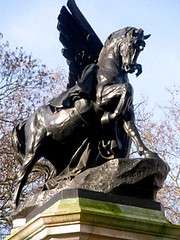 Royal Artillery Boer War Memorial | |
| Born | 25 December 1867 |
| Died | 13 November 1921 (aged 53) |
| Nationality | French |
| Education | Lambeth School of Art Royal Academy Schools |
| Known for | Sculpture |
During his career, Colton was a professor at the Royal Academy, president of the Royal British Society of Sculptors and full member at the Royal Academy.
Early life
Colton was born in Paris, France on 25 December 1867.[1] His father was an architect. In 1870 Colton left Paris for London.[2] He studied at the Lambeth School of Art in England[3] under William Silver Frith[4] before enrolling as a student in the Royal Academy in 1889. At the Royal Academy, he was taught by Henry Hugh Armstead and Sir Joseph Edgar Boehm.[2][3] He also studied in Paris.[1][2]
Career
Commissions
Within two years of his 20th birthday, Colton was exhibiting at both the Paris Salon and the Royal Academy.[1][2] Auguste Rodin and Alfred Gilbert provided inspiration for Colton's work.[1]
He received a commission from the Krishna Raja Wadiyar IV, Maharajah of Mysore and continued to receive commissions from India throughout his career.[5] Besides his engagements for work in England, Colton also received commissions for work in Australia and South Africa.[1][2] On 21 January 1903 Colton was elected as an Associate to the Royal Academy. He became a full member sixteen years later in 1919[1] on 25 April. In 1921 he became the president of the Royal British Society of Sculptors (RBS).[2]
Education
From 1907 to 1911 he was Professor of Sculpture at the Royal Academy.[2]
Works
Sculptures
This is a partial list of Colton's sculptures, busts and plaques.
| Name | Year | Comments | Exhibitions | Image |
|---|---|---|---|---|
| The Head | 1889 | Completed at Colchester Square, St. George's Square.[6] | ||
| The young St John | 1890 | Statue. Completed at St. John's Wood.[6] | ||
| A crown of glory | 1890 | Bust. Completed at St. John's Wood.[6] | ||
| Tender blossoms | 1892 | Head in terra cotta. Completed at St. John's Wood.[6] | ||
| D. G. Pinkney, Esquire | 1892 | Bust in terra cotta. Completed at St. John's Wood.[6] | ||
| Little Nell | 1896 | Fountain and Hyde Park, which "first drew notice to himself." The original has been replaced by a copy and is located in Hyde Park.[3][7][8] | ||
| The Image Finder | 1897 | The work was made in Eaton Studio, St. John's Wood.[6] | ||
| The Girdle/La Ceinture | 1898 | A bronze statue of a seated woman who is dressing for the day. Her hair is disheveled as she is in the process of putting on a girdle.[9] The work was made in Eaton Studio, St. John's Wood.[6] The statue was purchased by the Chantrey Fund Trustees and is in Tate Britain.[4] | 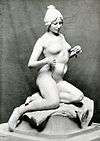 | |
| The Young Diana | 1902 | Bust. His Diploma Work, which can be seen at Burlington House.[10] | ||
| Dr. Henry Wells Armstead | 1902 | Bust, which can be seen at Burlington House.[10] | ||
| The River Unto the Sea | 1903[11] | 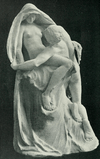 | ||
| In the Springtide of Life | 1903 | The work earned him election as an Associate of the Royal Academy and was also purchased for the Tate by the Chantrey Trustees. This work is now in the Harris Museum in Preston, Lancashire. Photograph courtesy of John Steedman.[12] | 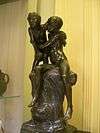 | |
| HH The Maharajah of Mysore | 1905 | Bust | Royal Academy.[13] | 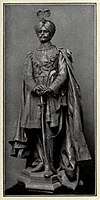 |
| King Edward VII | 1906 | The seated figure of King Edward VII at King Edward VII School, King's Lynn.[14] | ||
| Sir Sheshadri Iyer, Dewan of Mysore | 1907 | Bust | Royal Academy.[15] | |
| George and Sir Richard Tangye | 1908 | Bronze plaque in Birmingham Museum and Art Gallery.[16] | ||
| Love's Bondage | 1911 | The work is in the Art Gallery of New South Wales.[17] | ||
| Field-Marshal Earl Roberts | 1915 | Bust | Royal Academy.[15] | |
| Lieutenant-Colonel Sir George Roos Keppel | 1916 | Bust | Royal Academy.[15] | |
| Memorial to Sir Richard and George Tangye | 1916 | The bronze relief of the work is in Birmingham City Art Gallery.[18] | ||
| Marjorie Brassey | 1917 | Bust | Royal Academy.[15] | |
| Diana | 1917 | Bust | Royal Academy.[15] | |
| Rt Hon H H Asquith | 1920 | Bust | Royal Academy.[15] | |
| Explorer Captain Matthew Flinders | Unknown | The statue stands in front of the Mitchell Library in Sydney, Australia and was unveiled in 1925.[15] Photograph courtesy of Adrienne Bartl. | 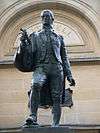 | |
| Angas Memorial | Unknown | The memorial is in Adelaide, Australia. Photograph courtesy of VCL4eva.[19] |  | |
| The Crown of Love | Unknown | The work was made in Eaton Studio, St. John's Wood.[6] Photograph courtesy of Picstout. | 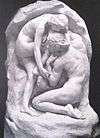 |
War Memorials
Worcester Boer War Memorial
The Worcester Boer War Memorial, located in the grounds of Worcester Cathedral, is a bronze depiction of a hatless figure who is protected by an angel. The memorial consists of a three-stepped base surmounted by a plinth, pedestal and figure of a soldier of the Worcester Regiment kneeling as he prepares to fire his last cartridge. A winged figure said to represent "Immortality" stands above him with a palm branch in one hand, and in the other hand a sheathed sword with laurel wreath on it. The memorial is dedicated to the men of Worcestershire killed in the South African War. It was unveiled on 23 September 1908 by Lt. Gen. the Hon. Sir N. G. Lyttleton. The monument was restored in 2005.[20]
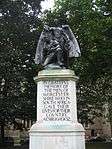 Worcester Boer War Memorial, photograph courtesy of Aled Betts.
Worcester Boer War Memorial, photograph courtesy of Aled Betts.
Royal Artillery Boer War Memorial
The Royal Artillery Boer War Memorial is on the corner of St James's Park in The Mall in central London. The memorial was designed by Sir Aston Webb and the bronze sculpture, including Pegasus and the two relief tablets, were executed by Colton. Completed in 1909 the composition was described by Colton as "War being controlled by peace, war being represented by a war horse & peace being a winged female figure." In the same letter Colton writes that the work "has become in a sense a part of the Queen Victoria Memorial Scheme."[21] The pillars list the 1,078 men who died in the South African war of 1899-1902 and relief panels show the unit in action. The memorial was unveiled in 1920 by the Duke of Connaught, using an electronic remote control from a memorial service in St Paul's Cathedral. The memorial was erected by the officers and men of the Royal Artillery in memory of their honoured dead.[22] The pedestal is in Portland stone and the sculpture, reliefs and panels with the names of those remembered, are all in bronze.[23]
 Royal Artillery Boer War Memorial
Royal Artillery Boer War Memorial- Relief on the Royal Artillery Boer War Memorial.
- Relief on the Royal Artillery Boer War Memorial.
W. T. Wyllie Memorial
The W. T. Wyllie memorial in Portsmouth Cathedral is positioned on the East wall of the Quire and east of the Corporation Pew and remembers the second son of William Lionel and Marion Amy Wyllie. William Thomas Wyllie served with the 2nd Durham Light Infantry and was killed in action at Montauban on the Somme on 19 July 1916. He was acting as a Brigade Major at the time and is buried in Mametz Cemetery. He left a widow and three children. The memorial features a sculptured figure in silhouette/high relief which lies along the bottom half. This figure is the dead body of an officer lying on his back, arms by his side. His shirt sleeves are rolled up and he wears braces, trousers and boots. His head rests on a cushion surrounded by a laurel wreath. The inscription is incised in white lettering along the top half of the memorial. The bronze founders were Messrs A. B. Burton.[24][25]
Captain F C Selous DSO
The memorial tablet dedicated to Captain F C Selous DSO is positioned at the head of the northwest staircase in the Central Hall. The figure and plaque are in bronze and the tablet is in stone. The memorial consists of a cast bronze portrait of Captain Selous in uniform and carrying a rifle. This is set into a niche in the stone tablet. Below the niche is a bronze relief of lions. The inscriptions are arranged in two side panels in raised block lettering. The sculptor's name is placed at the bottom right. The inscription on the left panel reads Caption Frederick C. Selous D.S.O. Hunter Explorer and Naturalist.. On the right panel Born 1851 Killed in action at Beho-Beho German East Africa 4 1 1917.. Selous was buried in East Africa in what is now Tanzania.[26]
 Selous memorial in Natural History Museum
Selous memorial in Natural History Museum Relief on Selous memorial
Relief on Selous memorial
Boyd and Claude Alexander
At St. Dunstans Church in Cranbrook, Kent, there is an alabaster memorial to Boyd and Claude Alexander who were both killed in action in Africa. Boyd Alexander served in the Rifle Brigade and was killed at Nyeri on 2 April 1910 and is remembered on the left side panel and Claud Alexander who served in the Scots Guards and was killed at Maifoni on 13 November 1904 is remembered on the right side panel. A representation of Africa in the form of a female figure holding arrows is positioned in the centre with busts of the two dead men on either side. The left hand panel includes representations of animals and trees and the right hand panel features a landscape scene.[27]
- Boyd Alexander
Staffordshire County War Memorial
The memorial, on Victoria Road, Stafford, was designed by Colton but his early death meant that the sculptor L. S. Merrifield had to complete the work. The memorial is dedicated to the soldiers from Staffordshire who died in service to their country during World War I. The memorial stands on a four-stepped base surmounted by two plinths and a column. In Colton's composition we see the figure of an angel with olive branch and a horse. This grouping is modeled after the Royal Artillery Boer War Memorial. There is a Staffordshire knot on the front face of the pedestal. The memorial was completed in 1923, following Colton's death. Earl of Dartmouth, whose son was one of the men memorialized by the monument, performed the unveiling.[28][29]
 Staffordshire County War Memorial, photograph courtesy of Mike Hillman.
Staffordshire County War Memorial, photograph courtesy of Mike Hillman.
Personal life
In 1902 Colton married Mignon Kroll de Laporte.[5] Two daughters were born to the couple.[5]
Robert Colton died at age of 53 on 13 November 1921 at St. Mary Abbot's Place, Kensington.[2] due to complications from a surgery approximately 4 weeks before his death.[2]
References
- Epstein, M.A. (ed.) (1921). The Annual Register: A Review of Public Events at Home and Abroad for the year 1922. London: Longmans, Green and Company. p. 154.
- William Robert Colton, Biography. Tate Collection. Retrieved 13 August 2012.
- William Robert Colton (1867-1921). The Victorian Web. Retrieved 13 August 2012.
- William Robert Colton, The Girdle. Tate Collection. Retrieved 13 August 2012.
- Chamaraja Circle | Everything about Mysore! Mysore.ind.in Retrieved 4 July 2012.
- Graves, Algernon. (1905). The Royal Academy of Arts: a complete dictionary of contributors from its founding in 1769 to 1904, Volume 2. London: Henry Graves and Company - and George Bell and Sons. p. 188.
- Hyde Park: Little Nell. Secret-london.co.uk Retrieved 4 July 2012.
- Mermaid Fountain: Little Nell. The Victorian Web. Retrieved 13 August 2012.
- Great Britain. Parliament. House of Commons. (1900) Sessional Papers: Reports from Commissioners, Inspectors and Others. Volume 26. p. 164. Note: Was at that time placed in the Gallery of British Art.
- Bust of "Young Diana RA Collections website. Retrieved 18 August 2012.
- River Unto the Sea. Mapping the Practice and Profession of Sculpture in Britain and Ireland 1851-1951, University of Glasgow History of Art and HATII, online database 2011. Retrieved 21 Aug 2012.
- In the Springtide of Life. Mapping the Practice and Profession of Sculpture in Britain and Ireland 1851-1951, University of Glasgow History of Art and HATII, online database 2011. Retrieved 21 Aug 2012.
- Royal Academy exhibitors, 1905-1970: a dictionary of artists and their work in the summer exhibitions of the Royal Academy of Arts, Volume 2. Royal Academy of Arts (Great Britain). EP Publishing, 1973. p. 61.
- American Institute of Architects. (1906). Quarterly bulletin containing an index of literature. Architecture. 7: 1-4. p. 305.
- William Robert Colton RA. Mapping the Practice and Profession of Sculpture in Britain and Ireland 1851-1951, University of Glasgow History of Art and HATII, online database 2011. Retrieved 19 Aug 2012.
- Foster, Andy. (2005). Birmingham: Pevsner City Guide. New Haven and London: Yale University Press. p. 68. ISBN 0-300-10731-5.
- Works by William Robert Colton RA PRBS (1867–1921): The Collection. Art Gallery NSW. Retrieved 4 July 2012.
- Tangye Plaque Details and photograph Tangye Plaque. Retrieved 20 August 2012.
- Comeron, Simon. (1997). Silent Witnesses: Adelaide's Statues and Monuments. Wakefield Press. p. 59. ISBN 9781862544024
- Royal Artillery Boer War Memorial. Victorian Web. Retrieved 20 August 2012.
- Papers reference WTW/8. Royal Academy of Arts Library & Archive.
- Matthews, Peter. London's Statues and Monuments. Shire Publications. PT 287. ISBN 978-0-74780-798-8.
- Royal Artillery - Boer War - Men Who Died War Memorial. Ministry of Defence: Roll of Honour. Retrieved 14 August 2012.
- UK National Inventory of War Memorials: W T Wyllie. Ukniwm.org.uk 19 July 1916. Retrieved 4 July 2012.
- Reading Room Manchester. Casualty Details. CWGC. 19 July 1916. Retrieved 4 July 2012.
- UK National Inventory of War Memorials: Capt F C Selous DSO. Ukniwm.org.uk Retrieved 4 July 2012.
- UK National Inventory of War Memorials: Boyd and Claud Alexander. Ukniwm.org.uk Retrieved 4 July 2012.
- Stafford Memorial Public Monuments and Sculpture Association. Retrieved 18 August 2012
- Noszlopy, George T. and Fiona Waterhouse. Public Sculpture of Staffordshire and the Black Country. Liverpool University Press. pp. 128-129. ISBN 0-85323-989-4.
Further reading
| Wikimedia Commons has media related to William Robert Colton. |
- Mary Chamot, Dennis Farr and Martin Butlin. (1964). The Modern British Paintings, Drawings and Sculpture, London.
- Spielmann, Marion Harry. (1901). British Sculpture and Sculptors of Today. London: Cassell. Internet Archive. Web. 22 December 2011.
- W(illiam) Robert Colton, RA. Mapping the Practice and Profession of Sculpture in Britain and Ireland 1851-1951. University of Glasgow History of Art and HATII, online database 2011. Web. 23 June 2011.